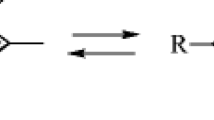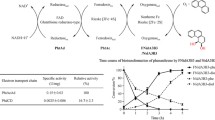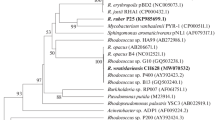Abstract
The evolved bphA1 (2049) gene, in which nine amino acids from the Pseudomonas pseudoalcaligenes KF707 BphA1 were changed to those from the Burkholderiaxenovorans LB400 BphA1 (M247I, H255Q, V258I, G268A, D303E, -313G, S324T, V325I, and T376N), was expressed in Escherichia coli along with the bphA2A3A4 and bphB genes derived from strain KF707. This recombinant E. coli cells converted biphenyl and several heterocyclic aromatic compounds into the highly hydroxylated products such as biphenyl-2,3,2′,3′-tetraol (from biphenyl), 2-(2,3-dihydroxyphenyl)benzoxazole-4,5-diol (from 2-phenylbenzoxazole), and 2-(2,5-dihydroxyphenyl)benzoxazole-4,5-diol [from 2-(2-hydroxyphenyl)benzoxazole]. The antioxidative activity of these generated compounds was markedly higher than that of the original substrate used.



Similar content being viewed by others
References
Barriault D, Plante M-M, Sylvestre M (2002) Family shuffling of a targeted bphA region to engineer biphenyl dioxygenase. J Bacteriol 184:3794–3800
Boyd DR, Sharma ND, Carroll JG, Allen CCR, Clarke DA, Gibson DT (1999) Multiple site dioxygenase-catalyzed cis-dihydroxylation of polycyclic azaarenes to yield a new class of bis-cis-diol metabolites. Chem Commun 1999:1201–1202
Boyd DR, Sharma ND, Belhocine T, Malone JF, McGregor S, Allen CCR (2006) Dioxygenase-catalysed dihydroxylation of arene cis-dihydrodiols and acetonide derivatives: a new approach to the synthesis of enantiopure terraoxygenated bioproducts from arenes. Chem Commun 2006:4934–4936
Furukawa K (2000) Engineering dioxygenases for efficient degradation of environmental pollutants. Curr Opin Biotechnol 11:244–249
Furukawa K, Suenaga H, Goto M (2004) Biphenyl dioxygenases: functional versatilities and directed evolution. J Bacteriol 186:5189–5196
Hudlicky T, Gonzalez D, Gibson DT (1999) Enzymatic dihydroxylation of aromatics in enantioselective synthesis: expanding asymmetric methodology. Aldrichimica Acta 32:35–62
Karlsson A, Parales JV, Parales RE, Gibson DT, Eklund H, Ramaswamy S (2003) Crystal structure of naphthalene dioxygenase: side-on binding of dioxygene to iron. Science 299:1039–1042
Kimura N, Nishi A, Goto M, Furukawa K (1997) Functional analyses of a variety of chimeric dioxygenases constructed from two biphenyl dioxygenases that are similar structurally but different functionally. J Bacteriol 179:3936–3943
Kubo K, Yoshitake I, Kumada Y, Shuto K, Nakamizo N (1984) Radical scavenging action of flunarizine in rat brain in vitro. Arch Int Pharmacodyn 272:283–295
Kumamaru T, Suenaga H, Mitsuoka M, Watanabe T, Furukawa K (1998) Enhanced degradation of polychlorinated biphenyls by directed evolution of biphenyl dioxygenase. Nat Biotechnol 16:663–666
Misawa N, Shindo K, Takahashi H, Suenaga H, Iguchi K, Okazaki H, Harayama S, Furukawa K (2002) Hydroxylation of various molecules including heterocyclic aromatics using recombinant Escherichia coli cells expressing modified biphenyl dioxygenase genes. Tetrahedron 58:9605–9612
Misawa N, Nakamura R, Kagiyama Y, Ikenaga H, Furukawa K, Shindo K (2005) Synthesis of vicinal diols from various arenes with a heterocyclic, amino or carboxyl group by using recombinant Escherichia coli cells expressing evolved biphenyl dioxygenase and dihydrodiol dehydrogenase genes. Tetrahedron 61:195–204
Sambrook J, Russell DW (2001) Molecular cloning: a laboratory manual, 3rd edn. Cold Spring Harbor Laboratory, Cold Spring Harbor, NY
Seeger M, Zielinski M, Timmis KN, Hofer B (1999) Regiospecificity of dioxygenation of di- to pentachlorobiphenyls and their degradation to chlorobenzoates by the bph-encoded catabolic pathway of Burkholderia sp. strain LB400. Appl Environ Microbiol 65:3614–3621
Shindo K, Kagiyama Y, Nakamura R, Hara A, Ikenaga H, Furukawa K, Misawa N (2003a) Enyzymatic synthesis of novel antioxidant flavonoids by Escherichia coli cells expressing modified metabolic genes involved in biphenyl catabolism. J Mol Catal B Enzym 23:9–16
Shindo K, Nakamura R, Chinda I, Ohnishi Y, Horinouchi S, Takahashi H, Iguchi K, Harayama S, Furukawa K, Misawa N (2003b) Hydroxylation of ionized aromatics including carboxylic acid or amine using recombinant Escherichia coli cells expressing modified biphenyl dioxygenase genes. Tetrahedron 59:1895–1900
Shindo K, Nakamura R, Osawa A, Kagami O, Kanoh K, Furukawa K, Misawa N (2005) Biocatalytic synthesis of monocyclic arene-dihydrodiols and -diols by Escherichia coli cells expressing hybrid toluene/biphenyl dioxygenase and dihydrodiol dehydrogenase genes. J Mol Catal B Enzym 35:134–141
Suenaga H, Mitsuoka M, Ura Y, Watanabe T, Furukawa K (2001) Directed evolution of biphenyl dioxygenase: emergence of enhanced degradation capacity for benzene, toluene, and alkylbenzenes. J Bacteriol 183:5441–5444
Taira K, Hirose J, Hayashida S, Furukawa, K (1992) Analysis of bph operon from the polychlorinated biphenyl-degrading strain of Pseudomonas pseudoalcaligenes KF707. J Biol Chem 267:4844–4853
Zielinski M, Kahl S, Hecht HJ, Hofer B (2003) Pinpointing biphenyl dioxygenase residues that are crucial for substrate interaction. J Bacteriol 185:6976–6980
Acknowledgments
This work was supported in part by the Biotechnology and Medical Technology Development Department of the New Energy and Industrial Technology Development Organization (NEDO).
Author information
Authors and Affiliations
Corresponding author
Rights and permissions
About this article
Cite this article
Shindo, K., Shindo, Y., Hasegawa, T. et al. Synthesis of highly hydroxylated aromatics by evolved biphenyl dioxygenase and subsequent dihydrodiol dehydrogenase. Appl Microbiol Biotechnol 75, 1063–1069 (2007). https://doi.org/10.1007/s00253-007-0928-6
Received:
Revised:
Accepted:
Published:
Issue Date:
DOI: https://doi.org/10.1007/s00253-007-0928-6




